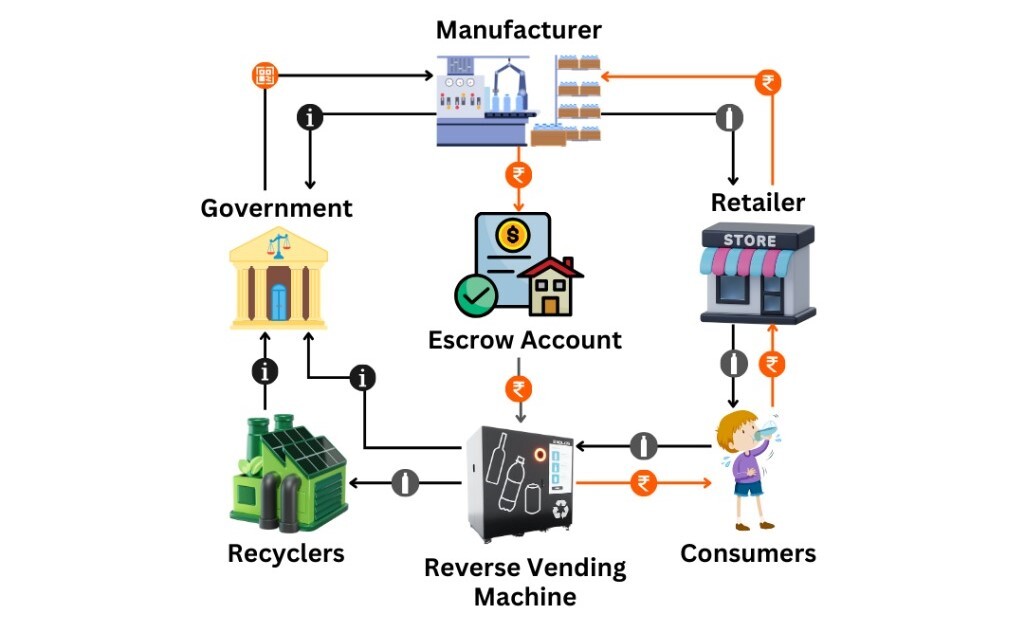Introduction
Imagine a world where empty bottles and cans don’t end up in landfills or littered across streets but are instead efficiently recycled, benefiting both the environment and consumers. That’s exactly what a Deposit Return System (DRS) aims to achieve. In this article, we’ll break down what a DRS is, how it works, and why it’s becoming an essential part of modern waste management. Plus, we’ll explore how reverse vending machine manufacturers and reverse recycling vending machines (RVM machines) play a key role in making these systems successful.
What is a Deposit Return System (DRS)?
A Deposit Return System (DRS) is a recycling initiative designed to encourage consumers to return used beverage containers by providing a financial incentive. When a customer purchases a bottled or canned drink, they pay a small deposit fee. After consuming the beverage, they return the empty container to a designated collection point, such as an RVM machine, and get their deposit back. This system has proven to be an effective way to reduce waste and increase recycling rates worldwide. Countries such as Germany, Norway, and Canada have implemented highly successful DRS programs, significantly reducing plastic pollution.
How Does a DRS Work?
The functioning of a Deposit Return System is quite simple and follows these steps:

Step 1 - Deposit Payment:
When purchasing a beverage in a recyclable container, the consumer pays a small additional fee as a deposit.
Step 2 - Consumption of Beverage:
The customer enjoys their drink, and instead of discarding the container in regular trash, they hold onto it for recycling.
Step 3 - Return of the Container:
The consumer brings the empty container to a collection point, usually a reverse recycling vending machine (RVM machine) or a designated recycling center.
Step 4 - Deposit Refund
Once the container is verified as eligible, the consumer receives their deposit refund, either in cash, store credit, or via a digital transaction.
Step 5 - Recycling and Reuse:
The returned containers are collected, sorted, and sent to recycling facilities, where they are processed into new products, closing the loop in the circular economy.
The Role of Reverse Vending Machines (RVMs) in a DRS
Reverse vending machines (RVM machines) are at the heart of a DRS. These automated machines accept used beverage containers and issue refunds to consumers.
How RVM Machines Work:
1. Scanning and Identification:
The machine scans the barcode or shape of the bottle/can to ensure it meets recycling criteria.
2. Collection and Sorting:
Once verified, the container is placed in an appropriate compartment for sorting.
3. Deposit Refund:
The consumer receives their deposit amount via a cash payout, store credit, or digital payment system.
Benefits of a Deposit Return System
A well-implemented Deposit Return System brings a range of environmental, economic, and social benefits:
1. Environmental Benefits:
Reduces littering and keeps streets and oceans clean.
Increases recycling rates, reducing the need for raw material extraction.
Lowers carbon emissions by cutting down on plastic waste.
2. Economic Benefits:
Creates job opportunities in the recycling and manufacturing industries.
Encourages the development of reverse vending machine parts and technologies.
Reduces municipal waste collection costs.
3. Social Benefits:
Engages communities in sustainable practices.
Encourages responsible consumer behavior.
Provides financial incentives, especially for lower-income groups.
Real-Life Examples of DRS Success
1. Germany’s Pfand System:
With a 98% return rate, Germany has one of the world’s most successful DRS programs. Consumers can return their bottles at any supermarket, where reverse vending machines instantly issue refunds.
2. CNorway’s Infinitum System:
Norway has achieved a 97% recycling rate thanks to its reverse recycling vending machines and efficient deposit system.
3. Lithuania’s DRS Impact:
The country’s deposit return system increased recycling rates from 34% to over 90% within just two years.
Practical Tips for Implementing a DRS
If your business, community, or country is considering adopting a Deposit Return System, here are some practical tips:
1. Invest in High-Quality RVM Machines:
Partner with trusted reverse vending machine manufacturers to ensure reliable and efficient recycling infrastructure.
2. Educate Consumers:
Run awareness campaigns to inform people about the benefits of using DRS.
3. Make Participation Easy:
Place collection points in accessible locations like supermarkets, malls, and public spaces.
4. Provide Multiple Refund Options:
Allow refunds through cash, digital wallets, or discounts to increase participation.
5. Regular Maintenance of RVM Machines:
Ensure proper servicing and availability of reverse vending machine parts to prevent system failures.
The Future of DRS and RVM Technology
With the rise of AI and smart technology, reverse vending machines are becoming more advanced. Innovations such as AI-powered sorting, contactless refunds, and blockchain- based tracking systems are improving efficiency and transparency in DRS programs.
More countries are recognizing the environmental benefits of implementing DRS, and businesses are investing in sustainable solutions, making reverse recycling vending machines an essential part of the future.
Conclusion: Take Action for a Greener Future
The Deposit Return System (DRS) is more than just a recycling initiative—it’s a step towards a cleaner planet and a sustainable future. With the help of reverse vending machine manufacturers and advanced RVM machines, we can reduce waste, conserve resources, and encourage responsible recycling habits.
If you’re a business looking to invest in sustainable solutions, consider integrating reverse recycling vending machines into your operations. Start contributing to a greener tomorrow— because every bottle returned is a step toward a cleaner Earth.
Want to learn more about how DRS and reverse vending machines can benefit your community? Visit Endlos Innovations for expert insights and innovative solutions in recycling technology!.